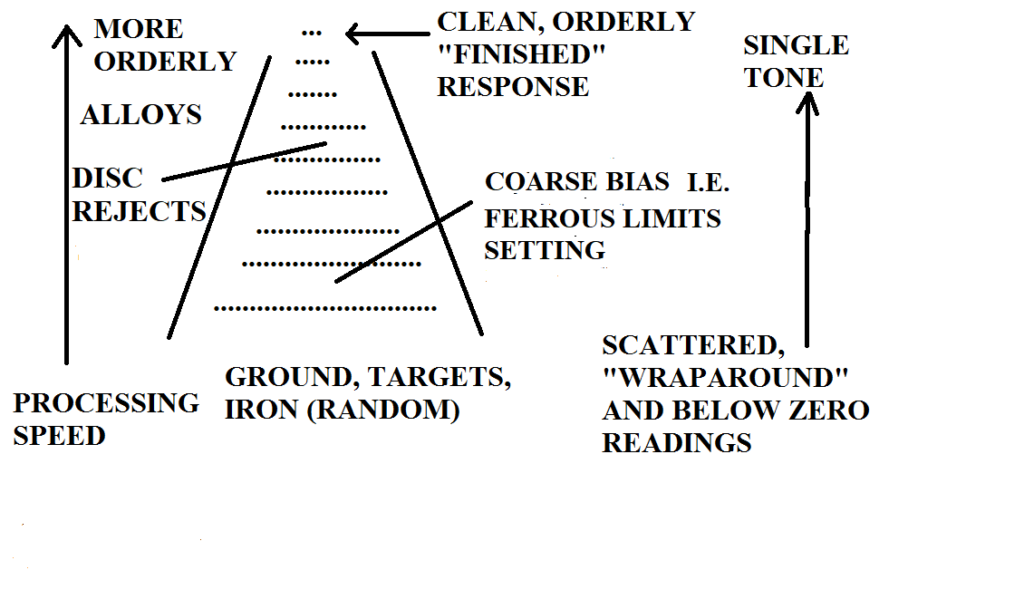2/ “Fast Digital and Then Some…”
The newest “crop” of detectors feature what’s termed “fast digital” processing. This processing was in effect–faster and more detailed than anything under the coil–ground, iron and targets. It’s safe to say that these types of circuits are making determinations measurable in the thousandths of a part. This means that the machine can audio and meter report with great accuracy–and separate targets from what they were resting in with great precision. Elements of this whole can then be subtracted–biased / filtered out. This is what gives the Minelab Manticore its remarkable ability to hit coins that are surrounded by nails–extremely thorough and detailed processing.
These machines also read within targets–reporting on the alloys they contain, or with targets that contain some iron or corrosion–both the ferrous and non-ferrous parts. All of this information is available to you. Whereas an analog signal is simply “the ground though a speaker,” (just like a simple pulse machine) a digital signal is more of a representation–kind of like the way a computer codes information into “ones and zeroes.” It’s removed from the actual ground by this codification. This allows all the great features that we see on a modern detector–amplification, tone menu options, precise ground balance and tracking (the list goes on)–these are this code as managed in software. Everything is converted into a “value.” Differences in these values are recognized as ground, iron and targets of various relative strengths. A good way to put it is that these detectors don’t detect metal–they detect anomalies.
What you have is gold-machine level processing applied to the task of normal detecting. It’s almost an “over-matching” limited only by the basic physics of what ground conditions will allow.

So when you see the Minelab Manticore advertised as having “50%” more power to the coil–this does not necessarily equate to depth–it equates to thoroughness of process. This power lets the Manticore process through / around all kinds of things: viscosity (black sand), fast salt water, complex audio and metering tasks, reject blocks, iron and diverse alloys–all at great speed.
“Multi IQ” enhances this processing / filtering by digitally locking the signal away from the volatile influences of iron–making for even better separation and reporting accuracy.
When you put a machine like the Equinox 800 or Manticore into its Prospecting mode this processing is well illustrated. The detector is more or less able to separate one part gold from 1000 parts black sand. How these machines perform this reduction has a lot to teach us about the overall platform.
A good way to understand this is to imagine a pyramid. At the base of this triangle we have the wide-responding, diverse signal of the ground, iron and any metal that’s under the coil. As we move upwards there are the various processes: bias, (promoting the more orderly parts of the response by way of audio filtering) and modulation (taking out more of the rough elements and screening for coin-sized targets), with Discrimination and Ferrous Limits acting to further refine the signal. Finally at the top of this pyramid we have the single (ideally) clean tone of a nugget or silver dime. With the Equinox 800 or Manticore’s Prospecting modes you can almost “hear” this process as the rough “sides” of the signal tone lag and boil down to the finished tone. If you take the ground’s massive random signal as a starting point, what the detector is doing is sounding off on “peaks” in this signal. The more distinct this “peak” is, the more distinct from the ground the target is.
Prospecting mode with either machine is more of a sharp, pointed triangle. This detailed processing lends itself well to the use of bias–or in the case of the Minelab Manticore, Ferrous Limits to focus upon less alloyed metals. With the Equinox I’ve used this clean, detailed high bias response to sort through shorelines littered with alloyed bottlecaps to find the gold.
From: “The Minelab Manticore: Tips, Tricks and Settings”
by clive james clynick